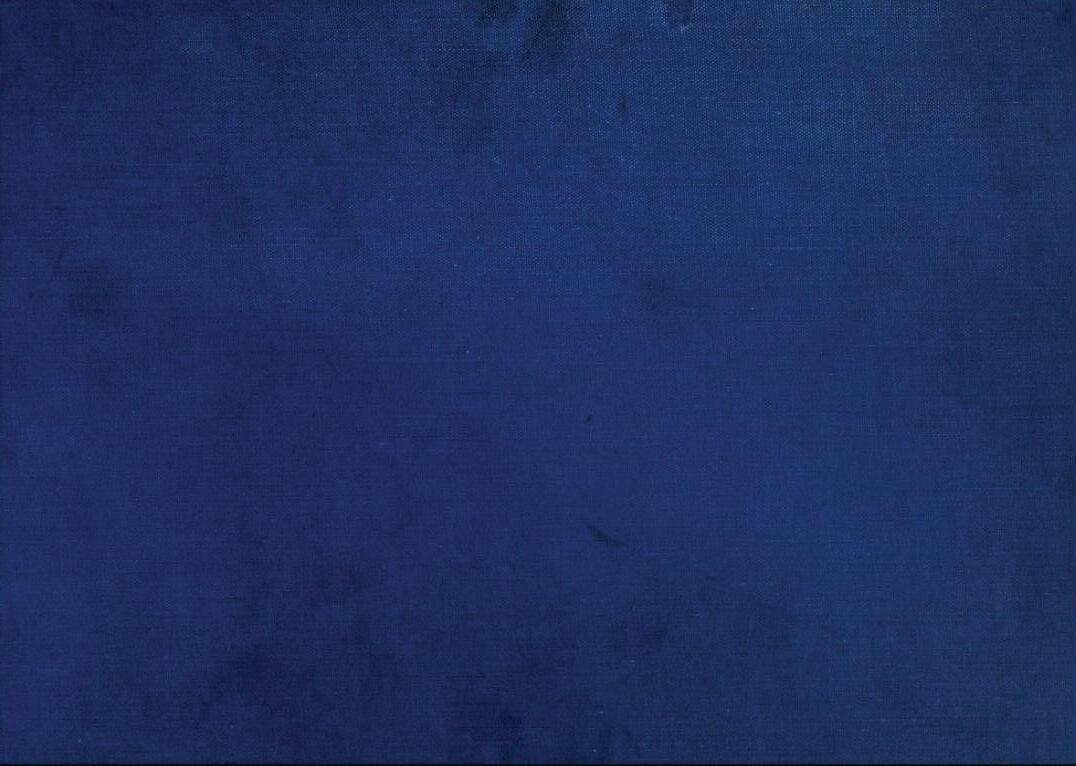
A walk through the halls and fair grounds of the Chicago World's Fair of 1893 by way of 16 cocktails at THE MEADOWLARK
Beverage Director: Abe Vucekovich
The Fair went by many names. Our favorite was not just in reference to the Fair, but to Chicago itself— The Magic City.




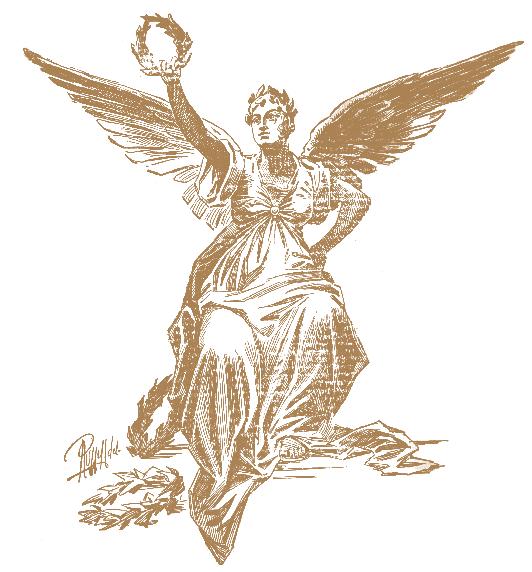
2
INTRODUCTION
The World’s Fair of 1893 was a hugely influential social and cultural event that had a profound global effect on architecture, the arts, and the image of Chicago after being rebuilt following The Great Fire of 1871.
Visionary architect Daniel Burnham oversaw the design and layout of the Fair, using it as an idealized prototype of his city planning. Amongst the many structures were 14 great buildings designed by prominent architects from around the world.




The World’s Fair spanned almost 700 acres in and around Jackson Park, representing 46 nations and welcoming 27 million fairgoers over the course of six months.
We welcome you to journey with us to the Chicago World’s Fair via cocktails inspired by its sites, sounds, and attractions.






4
Map KEY COCKTAILS $ 16
Golden Doorway · pg. 6
Streets of Cairo · pg. 8
Yerkes Telescope · pg. 10
Ferris Wheel · pg. 12
A Walk Through the Grounds of the Chicago World’s Fair
Horticultural Hall · pg. 14

Tiffany’s Chapel · pg. 16
Electricity Building · pg. 18
Woman’s Building · pg. 20
Viking Ship · pg. 22
Palace of Fine Arts· pg. 24
MacMonnies Fountain · pg. 26
Hööden Palace · pg. 28
Fisheries Building · pg. 30






Windmills · pg. 32
Haitian Pavilion · pg. 34
Wooded Island · pg. 36
a b c d e F g h i j k l m n o p e j h d B O m i A



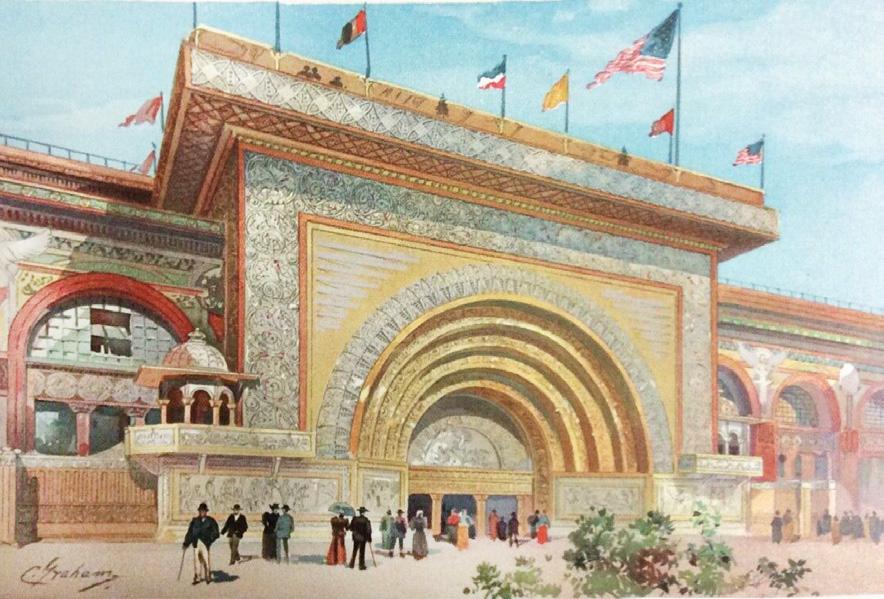



6
Golden Doorway
Golden Doorway
Smith & Cross Rum, La Favorite Ambre Rhum, Apologue Paw Paw Lemon, Chamomile, Sarpa di Poli Grappa
R ef R eshing , B R ight , t R opical






The Transportation Building’s Golden Doorway was designed by Louis Sullivan. It stood out from everything at the Fair, because the rebel Sullivan was very much against the pristine “White City” that Daniel Burnham insisted upon. The Golden Doorway was intricately designed with floral and leaf-like patterns. It became one of the biggest attractions at the Fair.

7
Streets of Cairo
Vusa African Vodka, Uruapan Charanda Blanco, Ancho Verde Watermelon, Lime, Hibiscus, Mint
✳ can be made non-alcoholic ✳
R ef R eshing , D elicate , f R uity
An Egyptian state agency that oversaw the conservation of Islamic monuments developed the complex of 27 buildings that became known as the “Streets of Cairo.” Chief architect Max Herz designed replicas of well-known buildings in Cairo—a mosque, a public fountain, and a kuttab (elementary Quran school). The buildings were mostly built in Egypt and shipped to Chicago, transporting fairgoers to the banks of the River Nile, where watermelons grow wild and residents sip on sugarcane-sweetened hibiscus tea.
8

Streets of Cairo 9








Yerkes Telescope 10
Yerkes Telescope
Buffalo Trace Bourbon, Ramazzotti
Lemon, Summer Berries, Lambrusco, Smoked Malört
R ef R eshing , f R uity , e a R thy
The Yerkes Telescope debuted at The World’s Fair at the Manufacturer’s Building as the largest telescope in the world. The 40-inch (102 cm) refracting telescope also introduced a doublet lens produced by the optical firm Alvan Clark & Sons, with a mounting by the Warner & Swasey Company. It now resides at The Yerkes Observatory in Williams Bay, Wisconsin.







11
Ferris Wheel
Daniel Burnham sought to rival the debut of the Eiffel Tower at the previous World’s Fair in Paris.
Civil engineer George Ferris invented a giant movable wheel, the first of its kind ever built. At night, the wheel was lit by approximately 2,500 bulbs and could be seen from across the fairgrounds. The Ferris Wheel would carry 2.5 million people from around the world to experience the Fair from on high.
R ef R eshing , Z ippy , B R ight
12
Singani 63 , Dolin Genepy, Melon L’Apéritif de L’Artisan Carpano Botanic, Lime, Herbsaint
Ferris Wheel

13







Horticultural Hall 14
Before you entered the Horticultural Hall, you were welcomed by a beautiful flower terrace. When you entered the building itself, you were surrounded by shrubs and flowering plants. Atop the center pavilion was a crystal dome, 117 feet high and 187 feet wide. Underneath the dome were massive palm trees, towering bamboo, and huge ferns. The many galleries featured viticulture, pomology, floriculture, and also wines to sample and enjoy throughout.







15
Tiffany’s Chapel
Barr Hill Gin, St. George Botanivore Gin, Lustau Manzanilla Sherry
Italicus, Crème de Violette, Regan’s Orange Bitters
s pi R ite D , f lo R al , D elicate
Designed by Louis Comfort Tiffany and his newly-founded Tiffany’s Glass and Decorating Company, the chapel was inspired by Byzantine religious designs with reflective surfaces everywhere. On either side of a white marble and glass altar stood three gold arches, each supported by green marble columns. Above stood a glass mosaic of two peacocks beneath a crown.
From the ceiling hung a vast chandelier of emerald glass orbs and an electrically-lit ten by eight foot cross.
16

Tiffany’s Chapel 17







Electricity Building 18
Electricity Building
The Fair, and especially the Electricity Building, showcased the pinnacle of innovation of that time. General Electric, backed by J.P. Morgan and Edison’s direct current, lost the bid to power the building to Westinghouse, backed by Tesla and his more efficient alternating current electricity. In response, General Electric and Edison prohibited the use of their bulbs to light the building. This prompted Westinghouse and Tesla to design their own—a double-stopper bulb to illuminate the Electricity Building and its attractions.







R ef R eshing , B R ight , e a R thy
Tromba Blanco Tequila, Mezcal Union El Joven, Suze, Lime, Tumeric
19
Woman’s Building
Uncle Nearest 1884 Whiskey, La Gritona Reposado Tequila
Pajarote Grapefruit & Rosemary Ponche
Zucca, Amaro Nonino, Puntamanguera Mezcal
The Woman’s Building showcased work by women from across mediums—art, literature, music, science, etc. Helmed by architect Sophia Hayden, the building was entirely organized and planned by women, and was the first building to be completed at the Fair. The contribution of the Woman’s Building to the first wave of feminism was significant; however, as with the feminist movement itself, it focused on contributions by white women and largely ignored innovations by women of color.
A portion of the proceeds from this cocktail will go towards Brown & Balanced
See pg. 40 for more information about their cause.
s pi R ite D , e a R thy , D elicate
20

Woman’s Building 21







Viking Ship 22
Viking Ship
✳ can be made non-alcoholic ✳
The World’s Fair sought to celebrate the 400-year anniversary of Columbus’ arrival to the “New” World. No attraction was as subversive to this as the reproduction of a Viking ship, which sailed all the way from Norway to Chicago. Many historians cite this as strong evidence that Columbus’ 1492 arrival was not the first European expedition to reach this continent. The Viking Ship is one of the rare large structures from the Fair that is still preserved today and can be visited in Geneva, Illinois.







R ef R eshing , s moky , f unky
Compass Box Glasgow Blend Scotch, Aalborg Aquavit, Cherry Heering Lemon, Sage, Seipp’s Extra Pale Pre-Prohibition Pilsner
23
Palace of Fine Arts
Botanist Islay Dry Gin, Mezcal Union El Viejo, Apologue Saffron
Lemon, Red Bell Pepper, Egg White, Peychaud’s, Black Sesame
✳ can be made non-alcoholic ✳
R ef R eshing , s avo R y , e a R thy
The Palace of Fine Arts showcased work by artists from around the world. The building itself was designed by Charles B. Atwood along with Daniel Burnham—a sky-lighted, oblong structure made up of a series of compartments that all intersected in a large rotunda surmounted by a massive dome. It was the only building with a perminant brick substructure and is still standing today— now the home of the Museum of Science and Industry.
24
Palace of Fine Arts

25







MacMonnies Fountain 26
MacMonnies Fountain







✳
can be made non-alcoholic
s pi R ite D , l uscious , e ffe R vescent
Pierre Ferrand Ambre Cognac, Pierre Ferrand Yuzu Curaçao Orgeat, Cava
The MacMonnies Fountain showcased steps of cascading waters flowing into the Grand Basin below. The sculpture was adorned by various figures such as Fate and Fame, all aboard a ship meant to represent forward progress. The painting shown here depicts fairgoers lighting their gondolas with paper lanterns, despite a practical electrically-powered boat having been invented 10 years prior. The Fountain’s proximity to the Electricity Building makes this contrast a bit ironic. ✳ 27
Hööden Palace
Mancino Sakura Vermouth, Oka Kura Bermutto
Takamine 8 yr Koji-Fermented Whiskey, Kiyomi Japanese Rum
D elicate , B R ight , f lo R al
The Hööden Palace was a set of three permanent buildings gifted to Chicago from the Emperor of Japan. The largest palace structure was known as The Phoenix Palace. The structures were built by Japanese workmen and was one of the first introductions of Japanese Architecture to the Midwest. The palace inspired many young fairgoers, one of whom was Frank Lloyd Wright.
28
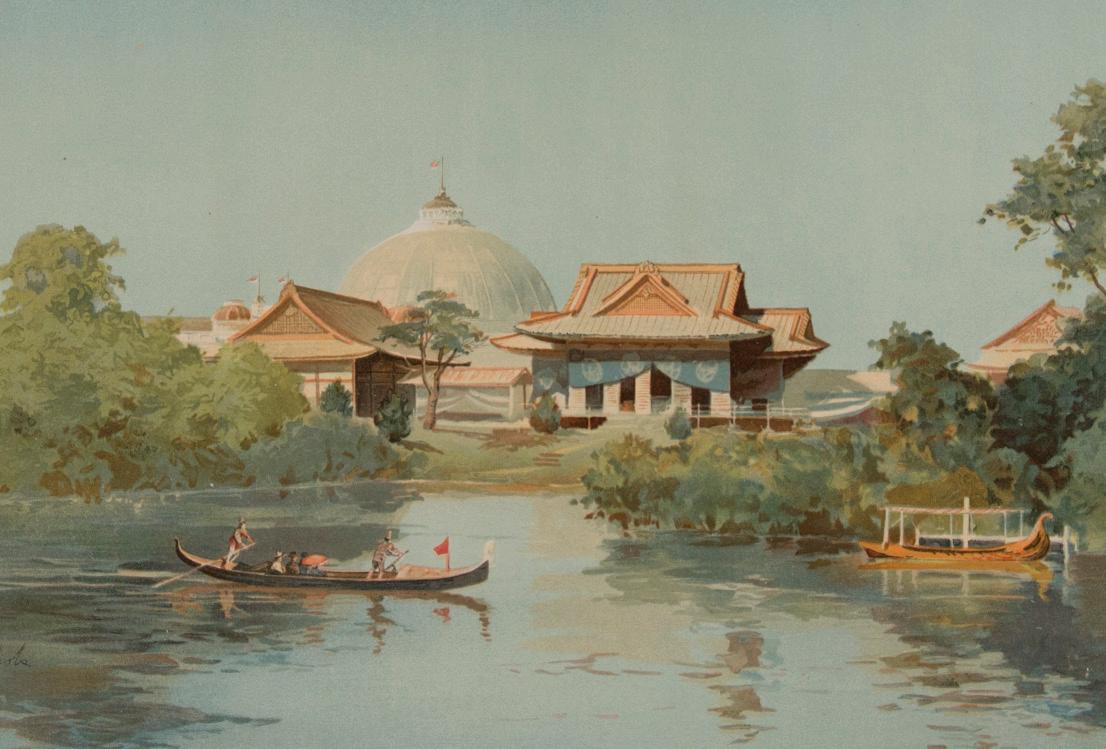
29 Hööden Palace



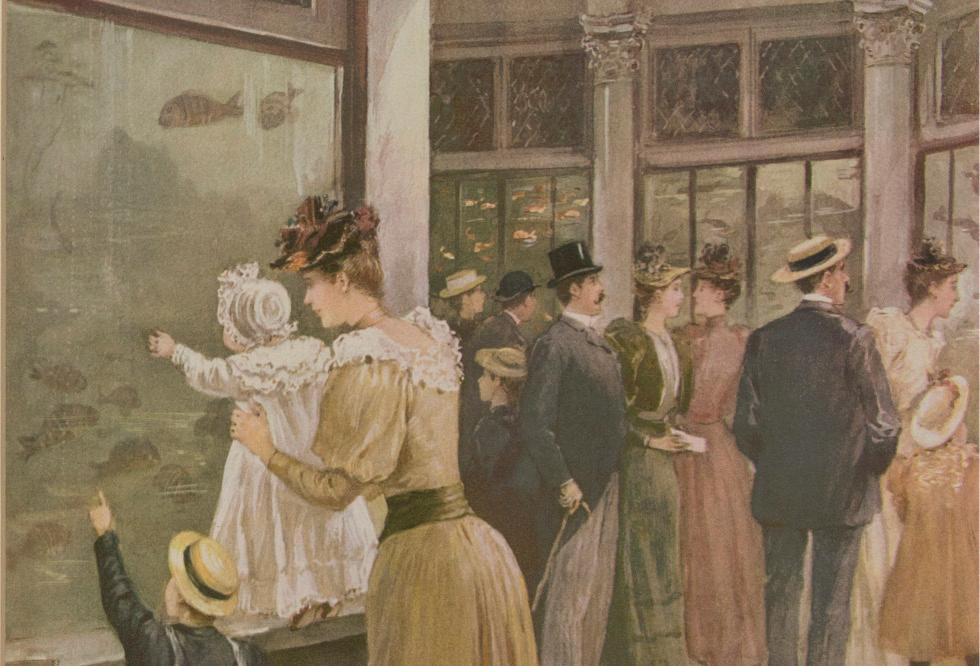



Fisheries Building 30
Fisheries Building
Aalborg Aquavit, Rhum Clément Martinique







Carpano Bianco, Green Chartreuse, Lime, Seaweed-Cucumber Shrub
B R ight , B R iny , v egetal
Nearly 600 feet of glass showcased an array of oceanic fish, a sight most fairgoers had not experienced before. The aquariums were lit with concealed electric lighting, which created the illusion for visitors that they were underwater. The tanks were filled with salt water from the Atlantic Ocean.
✳ can be made non-alcoholic ✳ 31
Windmills
Bols Genever, Cocchi Rosa, Tempus Fugit Crème de Cacao
Lemon, Cinnamon, Macurichos Espadin Destilado con Cacao
✳ can be made non-alcoholic ✳
R ef R eshing , l uscious , c omfo R ting
The largest of the windmills was constructed by the Blooker Cocoa Company. The windmill ground cocoa on site which was used to sell chocolate treats at the fair, namely hot chocolate. Fifteen additional windmills were displayed by the top windmill manufacturers of the time. The competition between windmill makers resulted in very tall, colorful, and powerful wind-driven machines, setting groundwork for wind-generated energy.
32
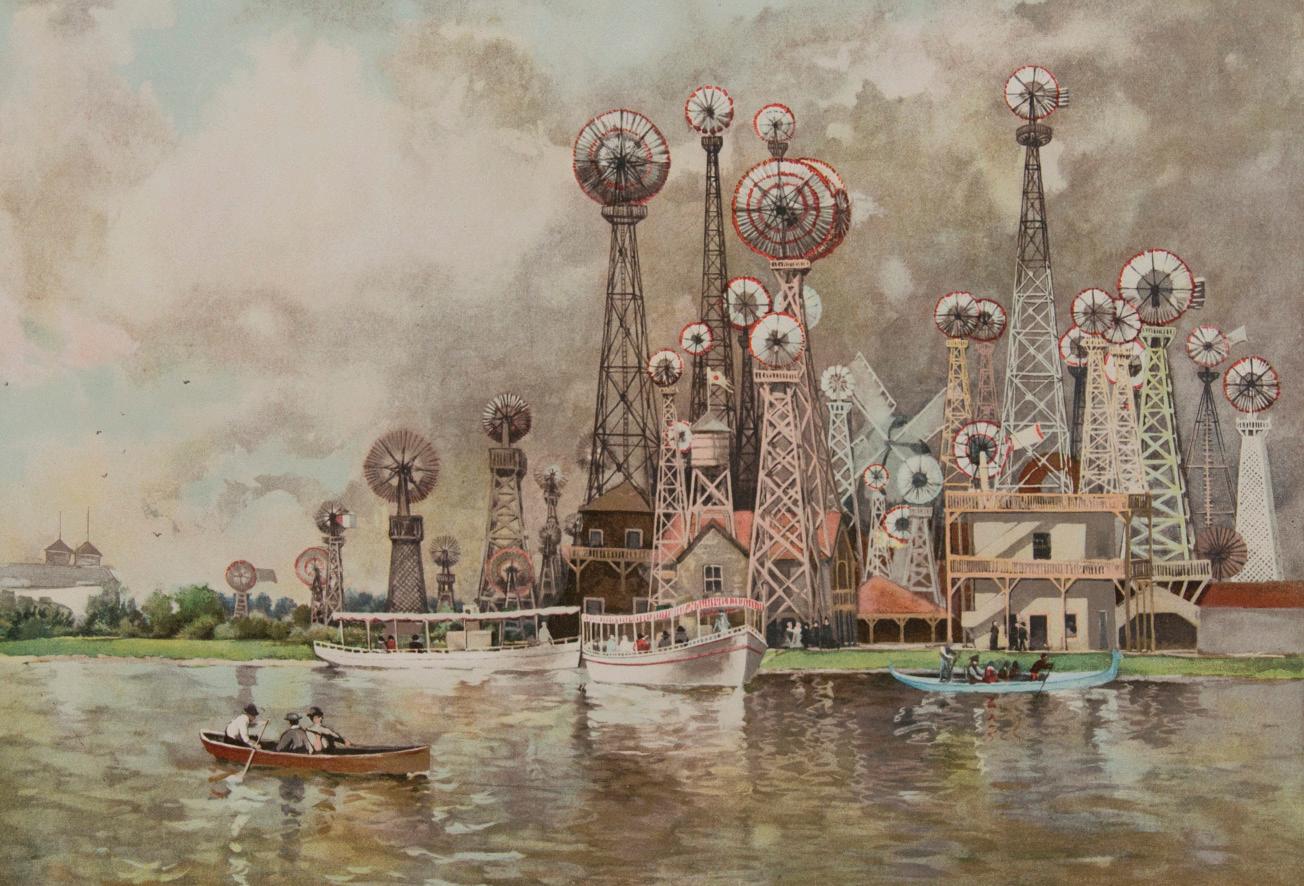
Windmills 33



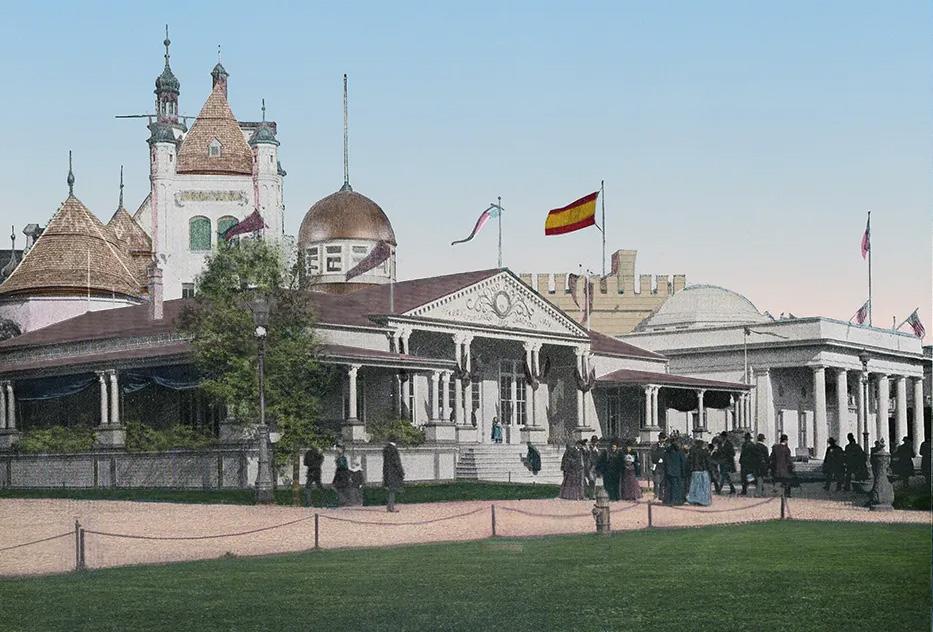



34
Haitian Pavilion
Haitian Pavilion
D elicate , f unky , f lo R al
The government of Haiti hired famed abolitionist Frederick Douglass to lead the development of this Pavilion, marking it as the only structure to officially include Black Americans in its planning. Pioneering activist Ida B. Wells co-authored the influential pamphlet The Reason Why, which she distributed to fairgoers inside the Pavilion to protest the exclusion of Black American cultural and technological innovations. As a result, a single day in August was designated to celebrate these achievements.







A portion of the proceeds from this cocktail will go towards Brown & Balanced
See pg. 40 for more information about their cause.
Clairin Milot Rhum, Cocchi Rosa, Salers
35
Albariza Oloroso Sherry, Smoked Orange Bitters
Wooded Island
Sazerac 6 yr Rye, Hamilton Jamaican Pot Still Black Rum
Averna, Heirloom Pineapple Amaro, Fernet Branca
s pi R ite D , e a R thy , l uscious
The Wooded Island was designed by Frederick Law Olmsted as an oasis for fairgoers from being amongst the crowds during a long summer day at the Fair. The Wooded Island showcased Japanese gardens that fairgoers could stroll through. At night, it was adorned with beautiful stone and paper lanterns. You can still visit the Wooded Island in Jackson Park, which has now grown to be a sanctuary for native Midwestern plants and birds.
36

Wooded Island 37
HISTORY OF SEIPP'S BREWING CO.

Conrad Seipp was a German immigrant who was one of Chicago's original brewers. He started making beer in 1854 and after surviving the Chicago Fire, the Conrad Seipp Brewing Co. became the city's biggest brewery for decades and sold their beers at the World's Columbian Exposition of 1893.

All Beers 16 Ounces $9
EXTRA PALE PRE-PROHIBITION PILSNER, 4.5% BAVARIAN HEFEWEIZEN, 5.2% COLUMBIA BOCK, 6.0% 1
38
2 3
The origins of Fratelli Branca date back to 1845 when Bernardino Branca and his three sons started producing and distributing Fernet-Branca. It soon became the World's most popular digestivo, made with over 27 herbs and spices, that to this day are a closely guarded family secret.

FERNET-BRANCA is now a days considered to be the best bitter ever known, and its beneficial effects are highly warranted around the world.


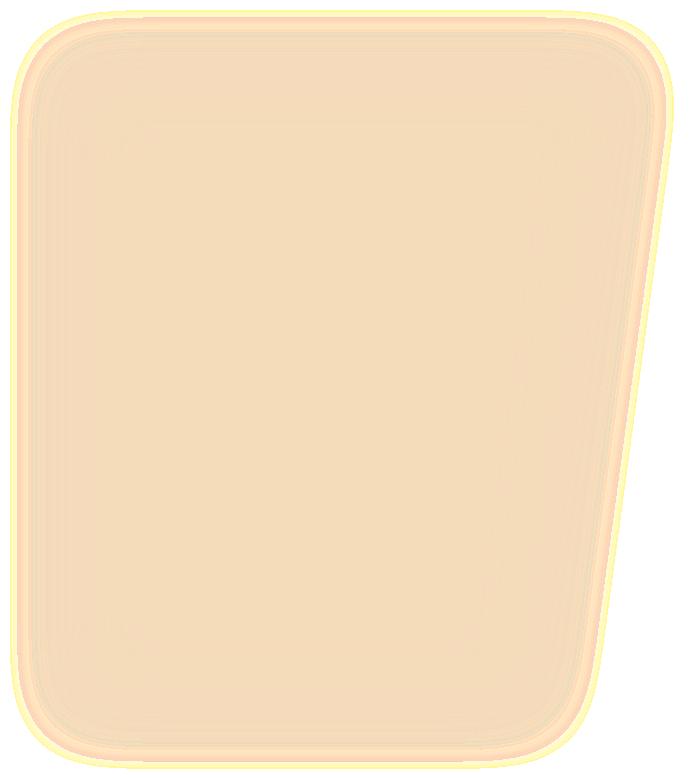
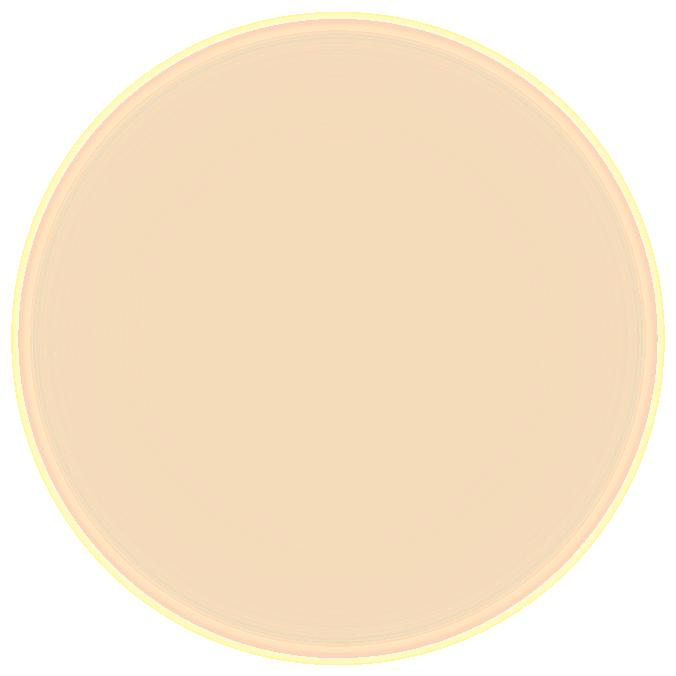
39
THE HISTORY OF FERNET-BRANCA $8
AFTERWORD
Representation and exclusion of certain minority groups at the Fair were problematic to say the least. Some cultures and countries were able to control how they were portrayed at the Fair. Other marginalized groups used their misrepresentation, or complete lack of representation, to speak out against racism and discrimination.
Simon Pokagon, an author and leader of the Potawatomi people, recited a speech at the World’s Fair condemning the malicious treatment and wrongful perceptions of Indigenous people in this country. We end this menu with the opening passage from his speech:
“Shall not one line lament our forest race, For you struck out from wild creation’s face? Freedom—the selfsame freedom you adore, Bade us defend our violated shore.”
Brown & Balanced:
A non-for-profit community organization that celebrates Black bar and hospitality professionals. Brown & Balanced hosts in-person events that celebrate Black culture and is dedicated to social media that spotlights Black talent while addressing social issues. To support and learn more, you can visit them at brownandbalanced.com
Special thanks to:
The Newberry Library, Chicago Tribune, Chicago Historical Society and Smithsonian for making their primary materials on The World’s Fair so accessible.




































